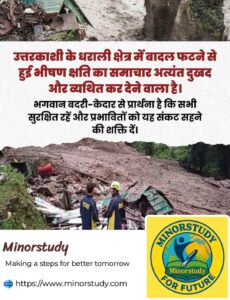🌧️ 5 Heartbreaking Realities About the Uttarkashi Cloudburst That Demand Our Attention
The sudden cloudburst on August 5, 2025, in the Dharali region of Uttarkashi district, Uttarakhand, shook the nation. Torrents of rain triggered devastating flash floods and landslides, sweeping away homes, shops, and dozens of lives in a matter of moments. This tragedy is a painful reminder of how swiftly nature can strike, leaving in its wake sorrow, uncertainty, and disruption.
- 🗓️ Timeline of Events
- 📊 Key Facts & Figures
- 🌍 Significance and Broader Context
- ❓ Frequently Asked Questions (FAQs)
- Q1. What exactly is a cloudburst?
- Q2. Why do regions like Uttarakhand experience such events?
- Q3. How many are confirmed missing or rescued?
- Q4. What agencies are leading the efforts?
- Q5. How can people help?
- 💖 A Message of Condolence and Hope
- ✅ Key Takeaways
- 🌱 Impact on Society and Daily Lives
- 🧭 Conclusion: Beyond Grief, a Call to Resilience
We remember the lost souls, pray for the recovery of the injured, and resolve to learn from this disaster. Here’s a deeply human, empathetic account of the event — covering history, facts, timeline, significance, social impact, FAQs, heartfelt wishes, and what it means for society today.
🗓️ Timeline of Events
5 Aug 2025: A cloudburst in the upper catchment area of the Kheer Ganga river around midday caused extremely heavy rain.
The resulting flash floods and mudslides devastated Dharali village and nearby settlements, washing away 20–25 hotels and numerous houses. Wikipedia+15Wikipedia+15Samayam Tamil+15
Multiple cloudbursts occurred—one in Dharali and another near Sukhi Top—amplifying destruction. www.ndtv.com+3Wikipedia+3Hindustan Times+3
Initial reports confirmed at least 4 deaths, while around 100 people remain missing, including several Indian Army personnel believed to be trapped. Hindustan Times+4People.com+4Wikipedia+4
Over 70 people rescued, with approximately 130 evacuated so far, amid ongoing torrential rain and difficult terrain. The Times of India+3Hindustan Times+3mint+3
📊 Key Facts & Figures
Casualties:
At least 4 people confirmed dead, with fears that the toll may rise. People.comHindustan Times
Around 100 individuals reported missing, including military personnel. YouTube
Destruction:
Nearly 20–25 hotels and guesthouses were completely washed away.
Whole village infrastructure collapsed—homes, marketplaces, and roads vanished. Wikipedia+6People.com+6Hindustan Times+6mint
Search & Rescue:
150 Indian Army personnel, NDRF, SDRF, ITBP, and local administration working urgently.
Rescue efforts involve drones, dogs, JCBs, helicopters, and night-time operations under relentless rain. Samayam Tamil+6Hindustan Times+6mint+6
Ongoing Danger:
Heavy monsoon rains and a Meteorological red alert till Aug 10 heighten the risk of further cloudbursts and landslides. Wikipedia+1
Historical Echoes:
Similar tragedies in Uttarakhand include the 2012 Himalayan flash floods and the 2021 Chamoli disaster, both resulting from rapid glacial or cloudburst-triggered floods. The Economic Times+13Wikipedia+13Wikipedia+13
🌍 Significance and Broader Context
🔹 Uttarakhand’s Ecological Vulnerability
This region, located in the fragile Himalayan ecosystem, is highly susceptible to climate change, unsustainable tourism, and unchecked development on unstable mountain slopes. The Uttarkashi tragedy echoes a pattern seen across the state. The Economic Times
🔹 Human Cost and Disruption
The suddenness of the event shattered lives and livelihoods. Locals, tourists, and business owners now face displacement and uncertainty, while regional connectivity—especially pilgrimage routes to Gangotri Dham—is severely disrupted. The Times of India
🔹 Response and Governance
Indian Prime Minister Narendra Modi and Home Minister Amit Shah have assured full assistance. Chief Minister Pushkar Singh Dhami is overseeing operations personally.CBS News+6Hindustan Times+6Wikipedia+6 But authorities must also reflect on long-term disaster preparedness and infrastructure planning.
❓ Frequently Asked Questions (FAQs)
Q1. What exactly is a cloudburst?
A cloudburst is an extremely heavy rainfall over a short period, typically causing flash floods in mountainous areas. They are highly unpredictable and devastating in terrain like Uttarakhand. The Sun
Q2. Why do regions like Uttarakhand experience such events?
Due to steep slopes, unstable geology, rapid unplanned development, and climate-change-influenced rainfall patterns, Himalayan regions face high disaster risk. The Economic TimesWikipedia
Q3. How many are confirmed missing or rescued?
So far, around 70 rescues have been made, about 130 people evacuated, and close to 100 individuals remain missing. mintHindustan TimesPeople.com
Q4. What agencies are leading the efforts?
The Indian Army, NDRF, SDRF, ITBP, along with local police and administration, form the frontline of the rescue operations. Hindustan Timeswww.ndtv.commint
Q5. How can people help?
Donations to verified disaster relief funds, volunteering through NGOs, and sharing helpline numbers responsibly can help. Residents should heed official warnings and avoid affected areas.

💖 A Message of Condolence and Hope
“We deeply mourn the loss of innocent lives in this tragic Uttarkashi cloudburst. May those injured heal swiftly, and may the souls of the departed rest in peace. Our prayers and support are with every affected family.”
✅ Key Takeaways
A sudden cloudburst on 5 August 2025 caused mass destruction in Dharali, Uttarkashi, washing away homes, hotels, and lives.
At least 4 confirmed dead, around 100 missing, dozens rescued.
Rescue efforts are ongoing amid heavy rain and risky terrain.
This incident highlights environmental fragility, climate change, and the need for better planning and preparedness.
Strong governance and public solidarity are critical to recovery.
🌱 Impact on Society and Daily Lives
This tragedy stirs larger reflections for society:
Natural disasters affect every layer of life—from local businesses to pilgrimages.
Ecological balance and sustainable tourism need urgent priority.
Building infrastructure resilience, especially in remote Himalayan regions, is a must.
Communities must be disaster-aware, with emergency plans, evacuation protocols, and early warning systems.
🧭 Conclusion: Beyond Grief, a Call to Resilience
The Uttarkashi cloudburst is more than a tragic news story—it’s a powerful reminder of nature’s might, our vulnerabilities, and our shared responsibility. As rescue continues, communities grieve, rebuild, and recover. But between these painful truths lies an urgent lesson: we must respect and protect fragile mountain ecosystems, build systems that can withstand disasters, and empower communities to face nature’s unpredictability with preparedness and unity.
May hope rise from the rubble. May solidarity bind us. May the memory of those lost guide a future built on resilience, compassion, and care.








